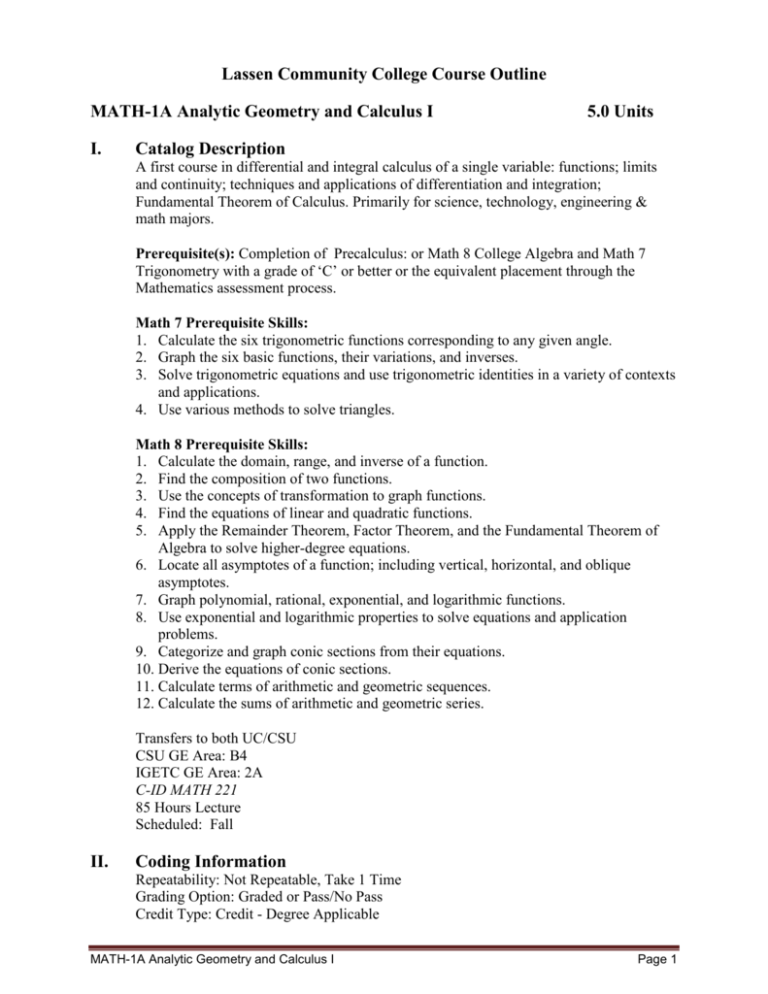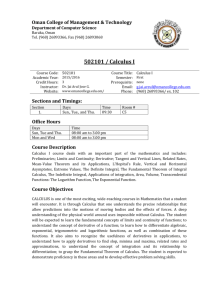MATH 1A Analytic Geometry and Calculus I
advertisement

Lassen Community College Course Outline MATH-1A Analytic Geometry and Calculus I I. 5.0 Units Catalog Description A first course in differential and integral calculus of a single variable: functions; limits and continuity; techniques and applications of differentiation and integration; Fundamental Theorem of Calculus. Primarily for science, technology, engineering & math majors. Prerequisite(s): Completion of Precalculus: or Math 8 College Algebra and Math 7 Trigonometry with a grade of ‘C’ or better or the equivalent placement through the Mathematics assessment process. Math 7 Prerequisite Skills: 1. Calculate the six trigonometric functions corresponding to any given angle. 2. Graph the six basic functions, their variations, and inverses. 3. Solve trigonometric equations and use trigonometric identities in a variety of contexts and applications. 4. Use various methods to solve triangles. Math 8 Prerequisite Skills: 1. Calculate the domain, range, and inverse of a function. 2. Find the composition of two functions. 3. Use the concepts of transformation to graph functions. 4. Find the equations of linear and quadratic functions. 5. Apply the Remainder Theorem, Factor Theorem, and the Fundamental Theorem of Algebra to solve higher-degree equations. 6. Locate all asymptotes of a function; including vertical, horizontal, and oblique asymptotes. 7. Graph polynomial, rational, exponential, and logarithmic functions. 8. Use exponential and logarithmic properties to solve equations and application problems. 9. Categorize and graph conic sections from their equations. 10. Derive the equations of conic sections. 11. Calculate terms of arithmetic and geometric sequences. 12. Calculate the sums of arithmetic and geometric series. Transfers to both UC/CSU CSU GE Area: B4 IGETC GE Area: 2A C-ID MATH 221 85 Hours Lecture Scheduled: Fall II. Coding Information Repeatability: Not Repeatable, Take 1 Time Grading Option: Graded or Pass/No Pass Credit Type: Credit - Degree Applicable MATH-1A Analytic Geometry and Calculus I Page 1 TOP Code: 170100 III. Course Objectives A. Course Student Learning Outcomes Upon completion of this course the student will be able to: 1. Analyze and solve calculus problems by the appropriate application of the principles of: limits, continuity, differentiation and integration. 2. Solve problems using numeric, graphic, and symbolic techniques. B. Course Objectives Upon completion of this course the student will be able to: 1. Compute the limit of a function at a real number. 2. Determine if a function is continuous at a real number. 3. Find the derivative of a function as a limit. 4. Find the equation of a tangent line to a function. 5. Compute derivatives using differentiation formulas. 6. Use differentiation to solve applications such as related rate problems and optimization problems. 7. Use implicit differentiation. 8. Graph funtions using methods of calculus. 9. Evaluate a definite integral as a limit. 10. Evaluate integrals using the Fundamental Theorem of Calculus. 11. Use the definite integral to find areas and volumes. IV. Course Content A. Definition and computation of limits using numerical, graphical, and algebraic approaches. B. Continuity and differentiability of functions. C. Derivative as a limit. D. Interpretation of the derivative as: slope of tangent line, a rate of change. E. Differentiation formulas: constants, power rule, product rule, quotient rule and chain rule. F. Derivatives of trigonometric functions. G. Implicit differentiation with applications, and differentiation of inverse functions. H. Higher order derivatives. I. Graphing functions using first and second derivatives, concavity and asymptotes. J. Maximum and minimum values, and optimization. K. Mean Value Theorem. L. Antiderivatives and indefinite integrals. M. Applications of integration to areas and volumes. N. Definite integral; Riemann sum. O. Properties of the integral. P. Fundamental Theorem of Calculus. Q. Integration by substitution. V. Assignments A. Appropriate Readings Students will be required to read and study the assigned chapters in the textbook. Supplemental readings are generally not assigned, but may be assigned. MATH-1A Analytic Geometry and Calculus I Page 2 B. Appropriate Writings 1. Prepare for class and review material and concepts presented in class. 2. Complete homework assignments, including applications of representative symbol systems and/or word problems. 3. Understand and apply the theories and techniques taught in the class. C. Expected Outside Assignments Students are expected to spend a minimum of 2 hours outside of class in practice and preparation for each hour of class. Assignments may include: reading the text, application of formulas and theorems, practice problems from the text. D. Specific Assignments that Demonstrate Critical Thinking Students will be required to interpret mathematical principles and techniques to solve broader and more difficult problems than those presented in class. Students will solve a variety of problems, including those that demand the application of principles in a number of different contexts. Multiple measures of student performance including inclass, out-of-class work, multiple exams, and final exam. VI. Methods of Evaluation Tests, examinations, homework or projcts where students demonstrate their mastery of the learning objections and their ability to devise, organize and present complete solutions to problems and a comprehensive final. VII. Methods of Delivery Check those delivery methods for which, this course has been separately approved by the Curriculum/Academic Standards Committee. Traditional Classroom Delivery Correspondence Delivery Hybrid Delivery Online Delivery Traditional Classroom Instruction consisting of (but not limited to) lecture, questions and answers, demonstrations, and discussion. VIII. Representative Texts and Supplies Larson/Edwards, Calculus, 10th Edition, 2014, Brooks/Cole, ISBN: 9781285057095 IX. Discipline/s Assignment Mathematics X. Course Status Current Status: Active Original Approval Date: 5/8/1990 Revised By: Noelle Eckley Curriculum/Academic Standards Committee Revision Date: 12/02/2014 MATH-1A Analytic Geometry and Calculus I Page 3











